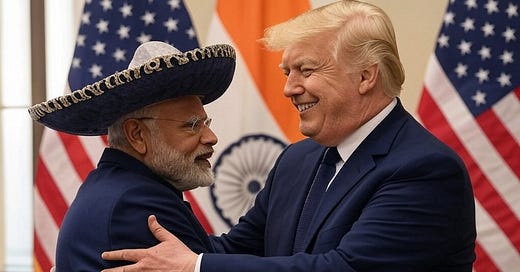Trump’s 26% Tariff on India: A Trade Showdown Leading to Economic Slowdown
Dost dost na raha? दोस्त दोस्त न रहा?
📬 GeoEconomy Watch | April 2025 Edition
Trump’s 26% Tariff on India: Economic Showdown Amid Global Trade Tensions
By Karan Bir Singh Sidhu, Retd. IAS
🔺 A Bold Strike from Washington
President Donald Trump has fired a fresh salvo in the global trade arena, announcing a sweeping 26% reciprocal tariff on Indian imports during his “Liberation Day” address. Set to take effect on April 9, 2025, this move targets critical sectors—automobiles, pharmaceuticals, textiles, engineering goods, and gems and jewelry—marking a significant escalation in economic hostilities between two major democracies.
While the announcement fits neatly into Trump’s broader “America First” doctrine, it has rattled markets, policymakers, and businesses across continents.
🏭 How India’s Economy is Bracing
The tariffs are poised to disrupt India’s export economy. Already, Tata Motors’ stock fell 5%, reflecting fears over Jaguar Land Rover’s exposure to the US market. India’s pharmaceutical exporters—leaders in the generic drug segment—are now preparing for heightened regulatory scrutiny and price volatility.
Other vulnerable sectors include garments, machinery, and IT-enabled services. However, India's growing internal consumption, diversified export strategy, and reduced dependency on a single market offer a measure of resilience.
🏛️ Senate Blocks Canada Tariffs: A Warning Shot to Trump
In a dramatic political twist, the U.S. Senate on April 2, 2025, voted 51–48 to block Trump’s new tariffs on Canada. Republicans Susan Collins, Lisa Murkowski, Mitch McConnell, and Rand Paul crossed the aisle, joining Democrats in a clear rebuke of the president’s trade policy.
This vote sent two powerful signals:
Internal resistance is mounting within Trump's own party.
Congress is reasserting itself as a check on executive trade powers.
Given its timing—just days before the India announcement—the vote underscores growing bipartisan discomfort with economic isolationism. It also raises the question: Could India tariffs face similar political headwinds?
🌐 Trump’s Global Tariff Doctrine: “Reciprocity or Retaliation?”
Trump’s trade policy hinges on reciprocal tariffs, punishing countries that impose high duties on US exports. But this tit-for-tat approach deviates sharply from decades of multilateral trade practices:
CountryEffective Tariff Rate China 54%, Vietnam 46%,European Union 20%, India26% (new proposed)
Supporters call it a correction of global trade imbalances. Critics warn it destabilizes long-standing alliances and undermines the WTO’s rule-based system.
💸 The Hidden Cost: U.S. Consumers Pay the Price
The rhetoric of "making foreign countries pay" often masks the real burden borne by American households and businesses. Analysts predict:
Annual cost increase of $1,600 to $2,000 per household.
Supply chain disruptions in pharmaceuticals, apparel, and auto parts.
0.6% projected dip in U.S. GDP for 2025.
As inflation concerns linger, these tariffs risk inflaming domestic discontent heading into a contentious election season.
⚖️ WTO Gridlock: A Silent Spectator
India could challenge the 26% tariff at the World Trade Organization under the Most-Favored Nation clause. But the WTO’s Appellate Body remains dysfunctional—a casualty of US obstruction since 2019.
Without enforcement teeth, the WTO is being sidelined just when global trade needs a credible referee the most.
🧭 Strategic Consequences: Cracks in the Indo-Pacific Coalition?
The tariff move threatens to erode trust in U.S.-India relations, which have flourished in recent years through QUAD cooperation, defense exchanges, and tech partnerships.
India may now deepen trade engagement with BRICS, Russia, or ASEAN as counterweights to Washington’s unpredictability. Similarly, the European Union has hinted at retaliatory action, signaling wider fractures in the Western economic bloc.
🤝 Beyond Trade: Rebuilding a Durable Partnership
To navigate this standoff, Washington and New Delhi must reinforce strategic convergence beyond economics:
QUAD must stay insulated from trade turbulence.
Educational, cultural, and visa ties should be protected to preserve goodwill.
Joint efforts in climate, cybersecurity, and infrastructure can help stabilize ties.
The tariff crisis could either sour a vital relationship—or catalyze its evolution into something deeper and more future-ready.
🧠 Editor’s Note: A Defining Moment
As tariffs transform from trade tools into geopolitical weapons, both India and the U.S. stand at a crossroad. Will confrontation give way to cooperation? Or will economic nationalism push allies into isolation?
This moment demands not just retaliation or compliance, but clarity of vision—to preserve prosperity, sovereignty, and strategic balance in an increasingly multipolar world.




